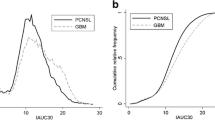Abstract
The aim of the study was to develop objective criteria that might be helpful for the diagnosis of gliomatosis cerebri (GC) with the highest possible probability based on both the neuroradiological and histopathological findings. Imaging findings in 14 patients with diffuse infiltrating brain neoplasms were studied by two neuroradiologists. Computed tomography and MRI scans were compared with each other side by side. The extent and kind of disease were graded on a scale of 1–5. Interexamination agreement between the two methods was calculated using a kappa analysis. Neither of the neuroradiologists performed the examinations and both were blinded to the histopathological findings, which were also available for all patients, based on biopsy as well as follow-up CT and MRI studies. A neuroradiological–neuropathological correlation was performed. A score system helped to differentiate the findings in three categories: 1 = suggestive of GC; 2 = GC cannot be excluded; and 3 = others. Both CT and MRI were performed in 14 patients with clinical signs and symptoms of an intracerebral tumor. All examinations had diagnostic quality and showed the involvement of at least two brain lobes. Stereotactic biopsy was carried out in all patients. In 2 patients the neuropathological diagnosis was suggestive of GC, in 1 patient glioblastoma, in 2 patients astrocytoma, and in 5 patients nonspecific astrogliotic proliferation. In the remaining 4 cases anaplastic tumor infiltration was diagnosed. The neuroradiological findings in 5 cases were suggestive of GC; in 6 cases a GC could not excluded; and in 3 patients only a slight probability of GC was found. In 2 cases was the neuropathological and the neuroradiological diagnosis of GC concordant. Magnetic resonance imaging is significantly more sensitive than CT in the diagnosis of GC. However, even with multiple, MRI-guided stereotactic biopsies in correlation with intraoperative analysis of the sample by smear preparations by a neuropathologist the antemortem diagnosis of GC is still difficult. Discussion of neuropathological and neuroradiological findings in each case in combination with a score system may help to resolve discrepancies.
Similar content being viewed by others
Author information
Authors and Affiliations
Additional information
Received: 3 March 2000/Revised: 1 August 2000/Accepted: 4 August 2000
Rights and permissions
About this article
Cite this article
Freund, M., Hähnel, S., Sommer, C. et al. CT and MRI findings in gliomatosis cerebri: a neuroradiologic and neuropathologic review of diffuse infiltrating brain neoplasms. Eur Radiol 11, 309–316 (2001). https://doi.org/10.1007/s003300000653
Issue Date:
DOI: https://doi.org/10.1007/s003300000653




